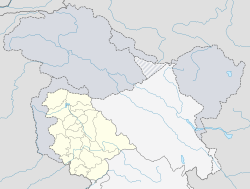Thikse Monastery
| Thikse | |
|---|---|

Thikse Monastery
|
|
|
|
|
| Coordinates | 34°03′23″N 77°40′00″E / 34.05639°N 77.66667°E |
| Monastery information | |
| Location | Thiksey, Ladakh, Jammu and Kashmir, India |
| Founded | Mid 15th century |
| Date renovated | 1980- new Maitreya Temple added |
| Type | Tibetan Buddhist |
| Sect | Gelug |
| Number of monks | 60 |
| Architecture | Fort monastery in the Central Tibetan pattern. |
Thiksay Gompa or Thiksay Monastery (also transliterated from Ladakhi as Tikse, Tiksey or Thiksey) is a gompa (monastery) affiliated with the Gelug sect of Tibetan Buddhism. It is located on top of a hill in Thiksey village, approximately 19 kilometres (12 mi) east of Leh in Ladakh, India. It is noted for its resemblance to the Potala Palace in Lhasa, Tibet and is the largest gompa in central Ladakh, notably containing a separate set of buildings for female renunciates that has been the source of significant recent building and reorganisation.
The monastery is located at an altitude of 3,600 metres (11,800 ft) in the Indus Valley. It is a twelve-story complex and houses many items of Buddhist art such as stupas, statues, thangkas, wall paintings and swords. One of the main points of interest is the Maitreya Temple installed to commemorate the visit of the 14th Dalai Lama to this monastery in 1970; it contains a 15 metres (49 ft) high statue of Maitreya, the largest such statue in Ladakh, covering two stories of the building.
In the early 15th century, Je Tsongkhapa, the founder of the Gelug School - often called "the Yellow Hats" - sent six of his disciples to remote regions of Tibet to spread the teachings of the new school. Tsongkhapa gave one of his disciples, Jangsem Sherab Zangpo (Wylie: shes rab bzang po), a small statue of Amitayus (the sambhogakāya form of Amitābha), containing bone powder and a drop of Tsongkhapa's own blood. Tsongkhapa directed him to meet the King of Ladakh with a message seeking his help in the propagation of Buddhism.
...
Wikipedia

